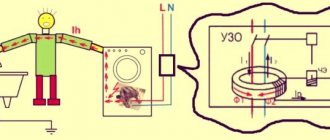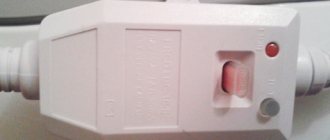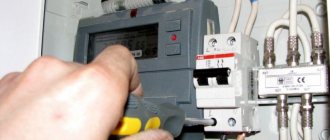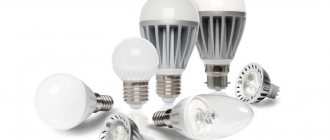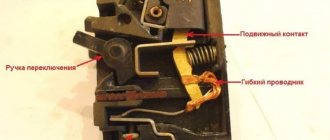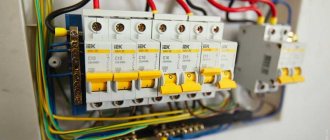I call on the League of Electricians. (Thank you, you can downvote) =)
He turned on the light in the large room. A lamp in the chandelier burst (one of three). At the same time, the machine switched off.
Questions: 1) What is the cause and what is the effect? Did it short out somewhere and that's why the lamp exploded and knocked out the machine? Or did the lamp cause the machine to be knocked out?
2) Where to look for the problem - only in the chandelier and its connections or check all the wiring up to the panel? (The wiring is new, there were no problems before)
Side question. Small splinters on the carpet. 3) Does it make sense to clean and how? Or is it easier to just throw out the carpet?
PS Please don't leave negative comments. As soon as the rating is visible, I don’t ask for more than 5 pluses so that the fresh stuff doesn’t immediately disappear.
No duplicates found
Light bulbs tend to _sometimes_ explode. I always turn away from them before turning them on for the first time, because... It is with the first that there is the greatest chance. (older fellow electricians taught me when I was young) There is most likely a metal base left in the socket, turn off the machine and unscrew it with pliers. Shine a flashlight inside and inspect the contacts for carbon deposits. Sometimes a light bulb fails precisely because it is not tightly pressed to the central contact: the light bulb is not screwed in enough (or the spring (they used to be under the central contact) has weakened, loose contact, heating, carbon deposits, which makes the contact even worse, etc.
I advise you to drag the carpet outside and beat it with a beater. (cover your eyes and breathing)
Morning summary. He took out the light bulb base. I did not find any traces of burning in the cartridge. He began to unscrew the second light bulb - the bulb remained in his hand, the base in the socket. (I found the name on the lamp - nifuya not Philipps, as I thought, someone installed Chinese shit)
I didn't find any traces in the cartridge. I have now installed new light bulbs. Good ones for sure. Now the light ticks quietly once every minute or two.
As I understand it, the base is heating up due to poor contact?
The light bulb shouldn't be ticking. Visually inspect the cartridges again. Check the contacts for burns and looseness. There are no miracles. Light bulbs, even branded ones, also have defects - production costs.
Well, as an option, you already have mania. Now you listen to everything and turn on the light.
Well, mania, yes. =)
“Yesterday the lamp broke” effect
+150 to hearing and attention.
It seems to have stopped ticking now. I've already taken it apart several times, sniffed everything, looked around, the contacts are all clean. I checked the connection points of the chandelier to the network. I checked the junction box, sniffed everything and looked through to the shield. Everything is clean everywhere. It seems to me that there were crappy lamps. And with a small jump they both jumped. One exploded. And the second was quietly and noiselessly dismantled onto the flask and base.
Tomorrow morning I’ll go see what’s wrong with the cartridge. Yes, it looks like metal.
We went over it with assembly tape, then with a vacuum cleaner. It’s good that he has a disposable bag, it’s not a shame to throw it away. There seems to be nothing left. But it's a little boring. Glass shards are a nasty thing.
That is, the short one in the socket is enough to screw up the lamp and knock out the shield?
In the wiring along the road from the shield to the chandelier, could there be some reason for the lamp exploding? I looked at the switch now, everything is clean, all connections are normal, there are no scorches anywhere, there is no burnt smell.
I was wrong about Philips. The light bulbs were crap. Now here's another problem(?)
Household appliance malfunction
After inspecting the sockets, it’s time for the distribution boxes. The wire connections in them must be of high quality, there must be no exposed parts, since they are the ones that can short-circuit.
Having finished inspecting the junction boxes, proceed to the lamps. A bad electrician may forget to check the chandelier when conducting such a study, and this can be a serious omission. Chandeliers are checked in the same way as sockets.
After you have inspected the sockets, light switches, distribution boxes and chandeliers, you need to start checking the electrical wiring. In most modern homes, electrical wiring is hidden, that is, hidden in the wall. To check it, you need to use a special device that accurately determines the location of the short circuit. However, only electricians usually have special equipment, and an ordinary person will have to be content with a multimeter. It may happen that with the help of it you will not be able to detect the “X” place, and then you should call a specialist with a thermal imager and other devices.
Saving electricity during a crisis
Entrance areas are being redecorated in apartment buildings. We are in the process of replacing lighting. We replace old lampshades with Chinese LED lamps. Various nuances occur from time to time. There is an example in my previous post. And here, this is how the apartment is powered from a common outlet.
Power Supply Polarity Determination
It happens that you have a DC power source (mobile phone charger, power supply, two powered ends on a car) and you don’t know which one is plus and minus, but you need to find out. There is neither a device at hand to find out, nor a diagram.
And here ordinary raw potatoes will help us. We cut the potato in half and stick two powered wires into it next to each other. The wire around which white foam
This is
a minus
, and where around the wiring
turns blue
is
a plus
.
Note:
the lower the voltage, the closer the wiring should be to each other.
Main causes of burnout
The reasons can be different - from power surges, poor-quality contacts in the electrical circuit to frequent switching on/off of devices, high temperatures, and vibrations.
Power surges
The industrial voltage is 220 V. If the actual value exceeds the required value, the tungsten filament overheats significantly, which shortens its service life.
A multimeter is used to check the voltage. Measure the value two to three times a day, since jumps are possible during a certain period. For example, this happens in the evenings, when people return from work or businesses connect to the electrical network at home. Another sign of high voltage is that parallel to the burnout of the light bulbs, the plugs and circuit breakers are knocked out.
If you detect power surges in the network, proceed as follows:
- buy lamps designed for higher voltage - for 230 - 240 V (look for the value on the packaging or on the base of the product);
- use a stabilizer installed in the first distribution box of the apartment (protects electrical appliances in the house);
- buy fluorescent lamps that are not affected by power surges;
- use LED products.
additionally install protective blocks for incandescent lamps on each switch (protect against overvoltage, ensure smooth switching);
Important! Knocking out traffic jams and machines is not always associated with increased voltage. This also happens in cases where the total power of electrical appliances connected to the network exceeds the permissible limit. Don't forget to short circuit the electrical wiring.
Poor quality contacts in the socket
Old domestic lamps used plastic sockets, and the cheaper the product, the lower the quality of the material itself. Ceramic cartridges are better, but are used less often. These lamps are designed for light bulbs up to 40 W. If you take a 60 W lamp, over time the socket will begin to crack. This will lead to oxidation and burning of the contacts. Poor contacts are another reason for the lamp to overheat and burn out.
If the light bulbs constantly burn out in one lighting fixture, and when the light is on, you hear extraneous sounds with a change in brightness, look for the cause in poor-quality contacts on the sockets. Clean them, replace burnt cartridges or the entire lamp. Avoid using devices with lamps of higher power than indicated in the lamp data sheet.
If the conditions are met, there is not enough light, switch to using luminescent products. Most modern lighting devices set an important requirement on the sockets - the power of the lamps used is not higher than 40 V. There is no need to limit the luminous flux and illumination of the room - it is possible to use fluorescent lamps.
Correct wire connection
The next reason is a wiring fault. Check the connections inside the electrical panel and tighten the screws that are responsible for securely fastening the cables.
If plugs and circuit breakers are knocked out when a light bulb burns out, be sure to check the compliance of the power of electrical appliances in the house with the electricity consumed. If a malfunction or insufficient power parameters are detected, the identified products must be replaced.
Examine the connections in each junction box of the apartment (private house). Pay attention to blackened wires and melted areas. Clean such contacts and tighten loose connections. Be sure to replace twisted wires with high-quality connectors.
Avoid galvanic pairs, when two or more cables of different metals are connected by twisting. In such areas, severe overheating occurs. If such cases cannot be avoided, use pads.
Problem switch
The next step is to check the switches. If such an element does not work correctly, incandescent lamps may also burn out. Disassemble and inspect the condition of the contact elements. If you notice sparks, carbon deposits on the contacts, or traces of blackness on the wires clamped with screws, get rid of the switch and install a new one.
If light bulbs turned on by one button burn out, do not disassemble the switch. Replace with a new one, additionally install a dimmer that provides smooth switching and the ability to change brightness.
Switches vary in terms of service life - replace the electrical product in a timely manner.
Poor quality lamp
Incandescent lamps from domestic manufacturers are significantly inferior in quality to their foreign counterparts. Lamps with a power of up to 60 W, most often used in everyday life, burn out. If previously domestic products were better in price, now their cost is comparable to devices from Osram and Philips factories. In this case, give preference to the latter group.
There are various recommendations for choosing lamps, but before you run to the store for foreign analogues, make sure that they are the problem.
Frequent activation
When turned off, the tungsten filament is cold, which is why its resistance is lower than that of the lamp when it is on (with a heated filament). When switched on, the current flowing through the electrical product is significantly higher. If frequent switching on/off occurs, the starting current will lead to rapid evaporation and breaking of the filament.
Vibration and mechanical stress
Constant vibrations, shocks and other mechanical impacts lead to rapid burnout of incandescent lamps. The way out of the situation is to replace conventional products with LED or compact fluorescent ones.
It would seem that everything is very simple. How to determine and from which end to look for a fault?
First, we gather and recall the events in our memory. When was the machine knocked out? What were you doing at this moment? Did it get knocked out when you turned on a specific device or was your husband hanging a shelf?
- The electrical appliance is faulty . If the circuit breaker tripped while you turned on an electrical appliance, you should turn off that appliance, turn the circuit breaker back on and turn on the same appliance again. If the machine is knocked out again, there may be several reasons. More on this below.
- Damage to electrical wiring . What were you doing when the machine was knocked out? Maybe they were hanging another shelf or driving a nail somewhere? This is a very common reason. You might not have completely interrupted the cable in the wall, but only touched it. With this point, everything is quite simple, if you damage the wiring in this way, then it is clear that at the moment of damage - the drill or hammer drill with which you made the hole will simply turn off. In this case, you will have to replace the damaged area.
- Overloads in the electrical network. If the machine knocks out randomly, then one of the reasons may be an overload in the electrical network. Let's say you have a circuit breaker with a rating of 16 amperes, and in the network after it you have 20 ampere devices connected. Over time, the cable heats up from the load and the circuit breaker trips, saving your electrical wiring from destruction. In this case, you should never install a machine with a large denomination. Yes, of course it will stop working, especially if you install a 63 A machine. It will most likely never work at all. But you also have every chance of one day returning home with a call from your neighbors that your apartment with a new super machine is on fire. You should never even listen to electricians who insist that you need to increase the rating of the machine, especially if the wiring in your apartment is made of old aluminum cable. This could lead to an even worse accident. If the machine turns off the network due to overload, rejoice, it works and performs its functions. But how can you be sure that it is the overload that knocks out the machine? It's simple, you can calculate the load that is on the network. We find out which sockets and lighting work from this machine, look at how much each electrical appliance consumes in these sockets. It will be especially good if you do this by calculating the load of all turned on electrical appliances at the moment of shutdown. We will receive some watts. Next, we pick up a calculator and use the formula I = P/U we count. I is the required load in Amperes, P is power in kilowatts, U is the voltage in our network. For example, you got 5000 watts, divide this figure by 220 volts of our network and get 23 amperes. Then we simply compare the resulting load with the rating of the machine. If the resulting figure greatly exceeds the machine’s nominal value, you should be careful.
use these outlets and reduce the number of electrical appliances that can be connected to the network at the same time. Also, if the electrical wiring is weak, you can use an additional device that will forcibly remove the non-priority consumer; read about this device in the article priority current relay. Also, without boring formulas and calculations, you can clearly, in real time, see the voltage and load in the network by installing a voltmeter - ammeter in the panel. - Poor contact . Poor quality connection and, as a result, poor contact. It could be anywhere. Starting from the circuit breaker itself, in which the contacts were not tightened well enough during connection. In distribution boxes, especially if the wiring is very old, but this is not uncommon in new wiring, especially if the installation is not done well enough, the quality of the wiring of the distribution boxes greatly affects the operation of the electrical network. The socket you are using is
can also organize a surprise for you, over time the contacts in it weakened and began to heat up and short out, you can often see sparking and hear a cracking sound when you plug the plug into the socket. Of course, such an outlet should be replaced. To find a bad contact, you should start looking from the circuit breaker itself, then sockets and switches. And after making sure the quality of their connections, look at the junction box. The first thing that may indicate poor contact is that the figure for load calculations is less than the rating of the machine itself. It is not recommended to carry out such work without certain skills. It is better to call a competent electrician who will carry out comprehensive diagnostics and determine the cause of the malfunction. - Often the circuit breaker trips when the incandescent light bulbs burn out. This happens for many reasons related to the light bulbs themselves and the quality of the electrical wiring in the apartment. Read more about this in the article about the reason for the frequent burnout of incandescent lamps, in which we discuss this issue in detail.
- Faulty circuit breaker or plugs. If you still have plugs, replace them. The malfunction of the circuit breaker itself can be judged after all of the above turned out to be normal.
Why do halogen lamps burn out?
Halogen lamps are rarely used in household appliances. These are mainly spotlights, less often chandeliers. One of the main reasons for failure is contact with bare hands, which leads to grease stains on the surface. The products overheat significantly, which causes the flask to collapse.
Use clean gloves during installation. If dirt is found, remove it with an alcohol-soaked cloth. Halogen lamps can burn out due to technically incorrect installation of electrical wiring going to the place where the spotlight is used.
Common reasons why a machine knocks out
In theory, a circuit breaker (CB) is a device designed to protect a certain section of the network from high currents and, as a result, damage to wiring and electrical equipment. Below we will consider the reasons why the machine may knock out.
Overload
As a rule, the machine turns off after some time due to an overload in the electrical network.
Each circuit breaker is designed for a specific operating current, for example, 6, 10, 16 or 25 A. This is the maximum load at which the circuit breaker normally performs its task.
As soon as the current in the network increases, the thermal element also senses it. At a certain moment it works, and the machine turns off. The higher the load current, the faster the circuit breaker turns off.
Let's look at an example in practice. An AB C 16, designed for 16 A, is installed at the entrance to the apartment. The voltage in the household network is 220 V, so the maximum power for connection is 2.52 kW. This load is consumed by a boiler and an electric kettle.
If a person also turns on the washing machine, the current will increase to 18-20 A. After a few seconds, the thermal element will work and the machine will turn off the power to the network.
The problem can be solved in one of the following ways:
- Alternately switching on powerful electrical appliances. For example, first you washed, then ironed, etc. It is not advisable for several powerful current consumers to work in the apartment at the same time.
- Replacing the wiring with a more powerful one or installing another circuit breaker. If a copper wire of 2.5 square meters is laid in the apartment, it will be enough for 16 A (aluminum conductors) and 20 A (copper conductors). This means that the maximum current of the machine that can be installed is 16 Amperes. If you need to install AB C 50 or higher, you will have to change the wiring, because the old wires will not withstand the load.
Please note that when you disconnect the machine from the thermal element, you will not be able to turn it on immediately. You will have to wait a few minutes until the bimetallic strip returns to its previous position.
Equipment breakdown
If the machine knocks when you turn on certain household appliances, for example, a washing machine or boiler, the cause may be a malfunction of this equipment.
To confirm or, conversely, refute fears, you need to turn off the “suspicious” equipment and turn on the machine again. If it stops beating, the reason has been found.
To identify broken equipment, you can connect electrical receivers one by one until the machine goes off. Once the problematic equipment is found, it must be sent in for repair.
Short circuit in wires
Another reason why the machine knocks out is damage to the wiring and, as a result, a short circuit. In a household network, a short circuit occurs when the phase and neutral wires touch.
As a result, the current flowing in the circuit increases tens of times (depending on the power of the power source). Sometimes this shutdown occurs with sparks.
To identify the cause of damage, it is necessary to disassemble switches and sockets and inspect them for destruction and damage. Dangling wires must be secured. Damaged sections of the wiring must be insulated, because they can lead to the appearance of a short circuit in the system.
After examining the boxes, move on to the lighting fixtures. Here, also check the reliability of the connections and make sure there is no damage to the wiring.
At the last stage, the integrity of the wires embedded in the wall is checked. To do this, a special device is used to find the break point. Unfortunately, there are no devices for finding the location of a short circuit in a wall with 220 V wires.
But you can use the following advice:
- Unplug all consumers from the sockets and turn off the packager;
- Take a multimeter, set the ringing mode (up to 200 Ohms) and ring all the sockets;
- Make a diagram of which sockets have a short circuit. This way you can identify the section of wiring in the wall where there is a short circuit.
But modern circuit breakers can turn off for other reasons:
- For example, in the packet phase there is poor contact and even when the refrigerator is turned on, it turns off. The reason is that sudden voltage surges occur in the phase, especially when loaded with a large inductance.
- If the ground is connected to zero.
If you can't find it, open the boxes and measure the voltage (resistance) with a multimeter. If you do not have the necessary experience, it is better to call an electrician who can quickly determine the location of the fault.
Machine breakdown
Sometimes the circuit breaker is knocked out due to the failure of the device itself. For example, a person installed a machine gun, but it turned out to be defective.
If the integrity of the wiring and equipment is not in doubt, pay attention to the condition of the device and, if necessary, replace it.
If a faulty AB is noticed before the warranty period expires, the device can be replaced at the place of purchase.
Recommendations for extending the life of incandescent lamps
The service life of light bulbs depends on the correct construction of the electrical wiring, the device used, power surges, mechanical shocks, temperature and the switch.
Prolonged operation of the product leads to overheating of the tungsten filament and its gradual evaporation. Because of this, the diameter decreases and the thread sooner or later burns out (breaks). The higher the heating temperature of the tungsten filament, the brighter the glow will be, characterized by a faster evaporation process and a shorter service life.
On average, the lamp is designed to operate for 1000 hours. After approximately 750 hours, the luminous flux decreases by 15%.
A slight increase in network voltage (about 5%) reduces the service life by half. This can be verified by observing lighting products installed on staircase landings, which constantly operate at night, when there is minimal load on the electrical network, which leads to an increase in voltage.
Since the tungsten filament is very cool when turned off, it is advisable to warm it up with a lower current before turning on the incandescent lamp at full power. To do this, install dimmers.
Rated voltage
Modern products do not indicate a specific voltage, but a certain range - from 215 to 225, 230 to 240 V. If the lamp is operated within this range, good luminous flux and durability are ensured.
This approach of manufacturers is associated with the difference in operating voltage of the network in its different sections. Near the source (substation) it will be higher than far from it. For this reason, you need to select light bulbs in accordance with the apartment’s network voltage. Measure it with a multimeter and if it turns out that the parameter is 230 V, buy incandescent lamps with a range from 30 to 240 V.
Checking the cartridge
If lamps in the same socket burn out frequently, check its operating temperature. If it is hot, disassemble the product, clean and bend the central and side contacts, and then tighten the wires going to the cartridge. If light bulbs in a chandelier often burn out, try using products of the same power.
Application of a protective diode
Recently, electricians have been using diodes installed in front of incandescent lamps on staircase landings. The quality of the voltage does not decrease, and the service life increases. If you connect a resistor in series with the diode, the light bulb will last for many years.
Refrigerator lighting
To illuminate the chambers in the refrigerator, small-sized incandescent lamps are usually used. They automatically turn on when the door is opened and turn off when it is closed. Typically, the lighting elements in the refrigerator last a long time, but if they begin to burn out constantly, it is necessary to eliminate the cause.
Miniature incandescent lamp for refrigerators
This may be a malfunction of the socket contacts, the use of light bulbs whose power exceeds what is technically provided, or the installation of low-quality lamps. First of all, it is necessary to check the connections and contacts in the cartridge and, if necessary, replace it with a new one. Such work can only be carried out in the refrigerator by disconnecting it from the electrical network.
You can replace incandescent lamps with LED lamps, which last much longer. In addition, this will help save some energy and improve the lighting in the refrigerator.
If incandescent lamps constantly burn out in your apartment, plugs often break out, and when you turn on the lights you hear a buzzing and crackling sound, it is necessary to urgently check and repair the electrical wiring. You should not do this yourself without the appropriate knowledge and experience. It's better to contact specialists.
